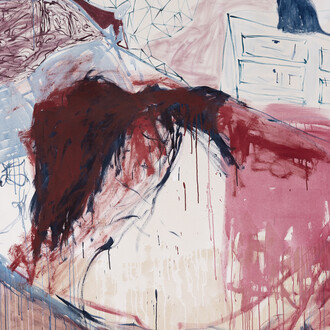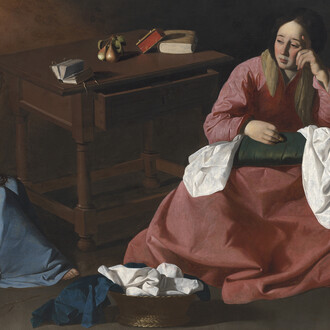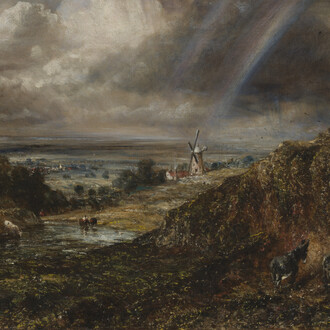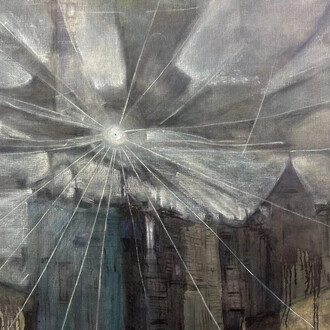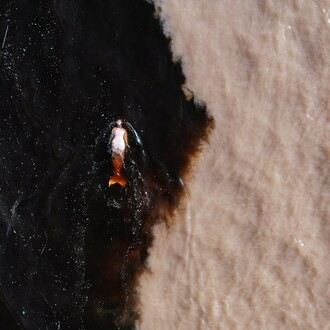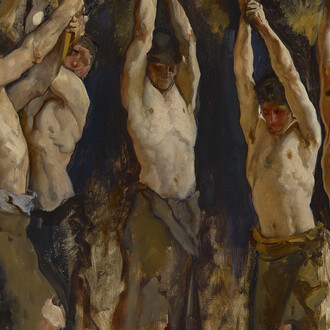Emalin is pleased to present Nuit, an exhibition of new paintings by Kate Spencer Stewart (b. 1984, Phoenix; lives and works in Los Angeles) created in response to La nuit (1886), a portfolio of lithographs by Odilon Redon (b. 1840, Bordeaux; d. 1916, Paris). Produced more than a century apart, these works approach the image as a mutable form, shaped by the contrasts of nocturnal and diurnal conditions. At the heart of this encounter is what Redon described as “the logic of the visible at the service of the invisible”: a visual language built on transformation, indeterminacy and inwardness.
Redon’s La nuit, issued in an edition of fifty, was part of a larger body of work he termed his noirs—drawings and lithographs developed in the decades following the Franco-Prussian War (1870). These works mark a departure from mimetic representation and the emerging optical logic of Impressionism. In their place, Redon cultivated a visual idiom grounded in suggestion and symbolic density. Shadow functions as the primary structural condition, holding figures in states of partial articulation and mystery. Lithography, with its oily depth and tonal instability, enabled Redon to conjure ambiguous forms—floating heads, chimeras, isolated eyes—suspended in black fields of uncertain space. For Redon, chiaroscuro was more than a technique of contrast. It served as a metaphysical proposition: the rendering of presence through obscurity. “Black should be respected,” he wrote, “nothing prostitutes it… it is the agent of the spirit.” He saw in black a capacity for interiority, a refusal of visual pleasure in favour of something more enduring. He treated materials as collaborators, insisting that “the material reveals secrets; it has its own genius… it is through it that the oracle will speak.”
Stewart likewise treats material as generative, as co-conspirator, remaining open to its contingencies as pentimenti accumulates–traces of hesitation, adjustment and return, echoing the word’s origin in pentirsi, to repent. No fixed image dictates the composition; the image forms within the limits of its own edge, emerging through processes of layering, obliteration and reiteration. Their development unfolds through a kind of call and response, each layer carrying forward a residue from the last. Her use of historically resonant pigments—lead white, warm earth tones with geological memory and early synthetic colour inventions—anchors the works within an expanded temporal field. In her practice, abstraction operates through small material shifts that sustain an ongoing negotiation, testing how far form, surface and material can be pushed before coherence strains, leaving the image open, provisional and formed through a continual responsiveness to process and material. Painted entirely by hand with a brush, the works bear the trace of natural processes: fractal growth, erosion, abrasion. At times their surfaces suggest exposure to chemical change or atmospheric stress. Others appear as if they have absorbed light for days, only to release it slowly. Each surface is shaped to appear as if it had simply arrived–natural and assured, rather than overly constructed.
Both artists draw from what might be called a medieval imaginary. Redon, raised in the Médocain region of southwest France, was influenced by local myth, mysticism and oral folklore. His works from the 1880s frequently feature visionary figures—seers, priestesses, creatures of uncertain taxonomy—that echo the allegorical modes of Gothic art and illuminated manuscripts. Medieval symbolism remained for Redon an active system of meaning, capable of addressing the limits of mimetic representation and giving shape to the inward. To the unmeasurable, to the sacred. In the wake of 19th century political upheaval and the rise of secular empiricism, the return to medieval motifs offered a way to think otherwise: toward the poetic and the metaphysical.
That return resonates now, too. While Stewart’s practice does not depict medieval subjects, it shares an orientation toward inwardness, iterative process and symbolic compression. Her working method recalls monastic modes: deliberate and devotional, sensitive to the belief that repetition can lead to transformation. Though there are no figures, there is a sense of individuation, each painting asserts its own presence and coherence. Chiaroscuro in her work becomes atmospheric as light and shadow activate shifts in visibility and depth. The surfaces generate perceptual instability, not unlike the ganzfeld effect, dissolving visual hierarchies and inviting prolonged, durational looking. Her square format reinforces this: without orientation, the viewer approaches from within, not above. Revealed in sequence, the paintings produce a rhythm of perception that echoes the structure of Redon’s poetic titles.
Installed within The Clerk’s House, the exhibition occupies a building shaped by its own layered history. Constructed in the early 18th century as a watchman’s residence for the adjacent cemetery, the site bears traces of earlier medieval structures and long histories of mortality, vigilance and spiritual attention. The preserved architecture—uneven floors, narrow staircases, timber panelling—introduces spatial disjunctions that frame the encounter with the works. Light filters irregularly through small windows, shifting across surfaces and altering their visibility as one moves through the rooms. Redon’s lithographs are at times installed within these interstitial zones—stairwells, passageways—allowing the architecture’s spatial intimacy and fragmentary qualities to mirror the structures of the works themselves.
Redon’s later work in pastel and oil did not abandon the noirs but extended their underlying concerns into chromatic space that would become foundational for the development of modernist abstraction. Stewart’s paintings take up abstraction as both a necessity and a problem: her work grapples with its hesitations, its instincts of refusal and its suspicions toward the adequacy of form. Drawn to the impossibility of fully capturing ambience and atmosphere, she pursues an expanded account of perception—one that accepts uncertainty, contingency and the limits of articulation as structural conditions. Nuit brings their work together through a shared commitment to the image as an unstable, active site: a place where material conditions and mental states converge. It proposes a shared attentiveness to what images can withhold, and what they can make possible. Across media, centuries and sensibilities, the work sustains an inquiry into how matter can think—how pigment, ink and shadow might generate meaning outside the demands of mimesis. It offers no resolution or stable ground, withholding definitive images or conclusions. Instead it places abstract painting in a space of ongoing negotiation, where questions of intent, expression and historical positions remain open and unsettled.









